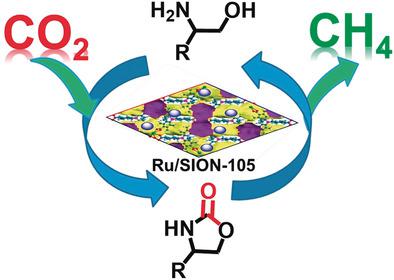当前位置:
X-MOL 学术
›
Angew. Chem. Int. Ed.
›
论文详情
Our official English website, www.x-mol.net, welcomes your
feedback! (Note: you will need to create a separate account there.)
CO2 Methanation via Amino Alcohol Relay Molecules Employing a Ruthenium Nanoparticle/Metal Organic Framework Catalyst.
Angewandte Chemie International Edition ( IF 16.1 ) Pub Date : 2020-06-09 , DOI: 10.1002/anie.202004618 Xinjiang Cui 1 , Serhii Shyshkanov 1 , Tu N Nguyen 2, 3 , Arunraj Chidambaram 2 , Zhaofu Fei 1 , Kyriakos C Stylianou 2, 4 , Paul J Dyson 1
Angewandte Chemie International Edition ( IF 16.1 ) Pub Date : 2020-06-09 , DOI: 10.1002/anie.202004618 Xinjiang Cui 1 , Serhii Shyshkanov 1 , Tu N Nguyen 2, 3 , Arunraj Chidambaram 2 , Zhaofu Fei 1 , Kyriakos C Stylianou 2, 4 , Paul J Dyson 1
Affiliation

|
Methanation of carbon dioxide (CO2) is attractive within the context of a renewable energy refinery. Herein, we report an indirect methanation method that harnesses amino alcohols as relay molecules in combination with a catalyst comprising ruthenium nanoparticles (NPs) immobilized on a Lewis acidic and robust metal–organic framework (MOF). The Ru NPs are well dispersed on the surface of the MOF crystals and have a narrow size distribution. The catalyst efficiently transforms amino alcohols to oxazolidinones (upon reaction with CO2) and then to methane (upon reaction with hydrogen), simultaneously regenerating the amino alcohol relay molecule. This protocol provides a sustainable, indirect way for CO2 methanation as the process can be repeated multiple times.
中文翻译:

采用钌纳米颗粒/金属有机框架催化剂通过氨基醇中继分子进行二氧化碳甲烷化。
二氧化碳(CO 2 )的甲烷化在可再生能源精炼厂的背景下很有吸引力。在此,我们报告了一种间接甲烷化方法,该方法利用氨基醇作为中继分子,与包含固定在路易斯酸性和坚固的金属有机框架(MOF)上的钌纳米颗粒(NP)的催化剂相结合。 Ru NPs 很好地分散在 MOF 晶体的表面,并且具有较窄的尺寸分布。该催化剂有效地将氨基醇转化为恶唑烷酮(与CO 2反应后),然后转化为甲烷(与氢气反应后),同时再生氨基醇中继分子。该方案为CO 2甲烷化提供了一种可持续的、间接的方式,因为该过程可以重复多次。
更新日期:2020-06-09
中文翻译:

采用钌纳米颗粒/金属有机框架催化剂通过氨基醇中继分子进行二氧化碳甲烷化。
二氧化碳(CO 2 )的甲烷化在可再生能源精炼厂的背景下很有吸引力。在此,我们报告了一种间接甲烷化方法,该方法利用氨基醇作为中继分子,与包含固定在路易斯酸性和坚固的金属有机框架(MOF)上的钌纳米颗粒(NP)的催化剂相结合。 Ru NPs 很好地分散在 MOF 晶体的表面,并且具有较窄的尺寸分布。该催化剂有效地将氨基醇转化为恶唑烷酮(与CO 2反应后),然后转化为甲烷(与氢气反应后),同时再生氨基醇中继分子。该方案为CO 2甲烷化提供了一种可持续的、间接的方式,因为该过程可以重复多次。











































 京公网安备 11010802027423号
京公网安备 11010802027423号